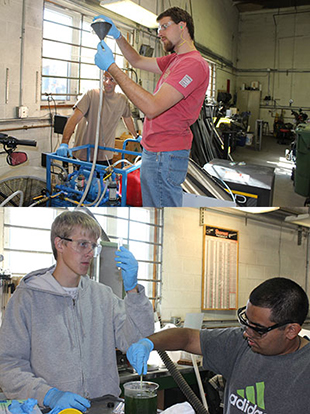Recipe for better fuel mileage to be presented at research review
News
Wouldn't it be nice to be able to mix water with gasoline to save some money at the pump-and benefit the environment too?
That idea may not be as far-fetched as it sounds, although it will involve more than just adding water from a garden hose. Gasoline engines cannot burn water, of course, and that’s why they stall when water gets into a gas tank. Under normal conditions, the two liquids don't mix.
But research in the JMU Alternative Fuel Vehicles lab is looking at a way to emulsify water with gasoline so that engines can still burn it. The project is one of several that will be presented at the annual Valley 25 x '25 Research Review on Wednesday, Oct. 24. The event is free and open to the public and will take place from noon to 5 p.m. in Room 259 of the ISAT/CS building on the JMU campus east of Interstate 81. Visitor parking will be available. For parking information contact Ben Delp (delpbt@jmu.edu).
Valley 25x'25 is based at JMU and promotes using a diverse energy portfolio to achieve 25 percent renewable energy in the Shenandoah Valley before 2025. Other projects to be presented include an investigation of ways to harvest algae for biofuel production, biodiesel gas chromatography and using poultry litter as fuel.
In theory, a gasoline-water mixture, or emulsion, would improve fuel mileage while also reducing harmful exhaust emissions.
So far, Joe Crosbie, a senior honors student majoring in integrated science and technology, has only done tests emulsifying water with diesel fuel and running it through a tractor-trailer engine. The results from tests he performed in Pennsylvania this summer were mixed. Poisonous emission levels, such as carbon monoxide and particulate matter, reduced by 50 percent, but fuel economy went down about 2 percent.
Crosbie is running the tests again at JMU using a gasoline-powered Harley Davidson motorcycle. The motorcycle is situated on a dynamometer, a machine that enables Crosbie to run the motorcycle in place in the lab. The motorcycle is hooked to an emulsion combustion unit that emulsifies a small amount of water with gasoline.
The creator of the ECU, Eric Cottell, and the manager of a Shenandoah County company that manufactures the ECU, Wesley G. Pence, received a $100,000 award for the device during an international competition in September, beating out 60 other projects from 16 countries. Both men are working with Crosbie and supporting his research.
Dr. Chris Bachmann, associate professor of integrated science and technology, said one of the theories behind getting better fuel mileage with an emulsified blend is that the water will be converted to steam by heat in the engine that is normally wasted. Engines send that heat out through the cooling system, but if it could be turned into steam it would help push the pistons, ultimately getting that energy to drive the wheels. Bachmann said Crosbie will test a wide range of water/fuel ratios to see if there is a "sweet spot" that reduces emissions and saves fuel.
In addition to the support from Cottell, president of Nonox, LTD., and Pence, manager of research and development for Wholesome Energy of Edinburg, Valley 25 x '25 funded Crosbie's summer internship to work on the project.
A Better Way to Harvest Algae
Also presenting at the symposium will be Caleb Talbot, another senior ISAT major, and Premal Patel, a senior at Harrisonburg High School, who are researching ways to harvest algae that can be used to make biodiesel.
Among the benefits of getting oil from algae is that the plant reproduces rapidly and can be grown in the ocean where it does not compete for farmland used to grow food for people and animals. One of the hurdles to making algae biodiesel practical is finding ways to harvest it that require less energy than it will produce.
Talbot said he has researched eight to 10 different harvesting methods and is focusing on two for his senior project. One involves electrolysis, where he runs electric current through a container of saltwater and algae. The electrolysis causes the water's hydrogen and oxygen molecules to separate, with hydrogen gas bubbling to the surface. Since hydrogen atoms have a positive charge, they attract the negatively charged algae, which cling to the hydrogen and ride to the top. The algae that rises to the top can then be skimmed out and put in beakers to dry. Once it is dry, oil can be removed by pressing the algae or mixing it with solvents.
Talbot also wants to see if the oil can be extracted by mixing algae and solvents in the Nonox ECU.
As for the promise of algae biodiesel some day easing the dependence on petroleum diesel, Talbot is excited. "The earth gets hit with an amazing amount of the sun's energy, but the earth's surface is two-thirds water. When you look at the size of the potential zones for growth, they're almost continental. The potential is there for some huge-scale production. The technology is not there yet, but the potential is huge," he said.

